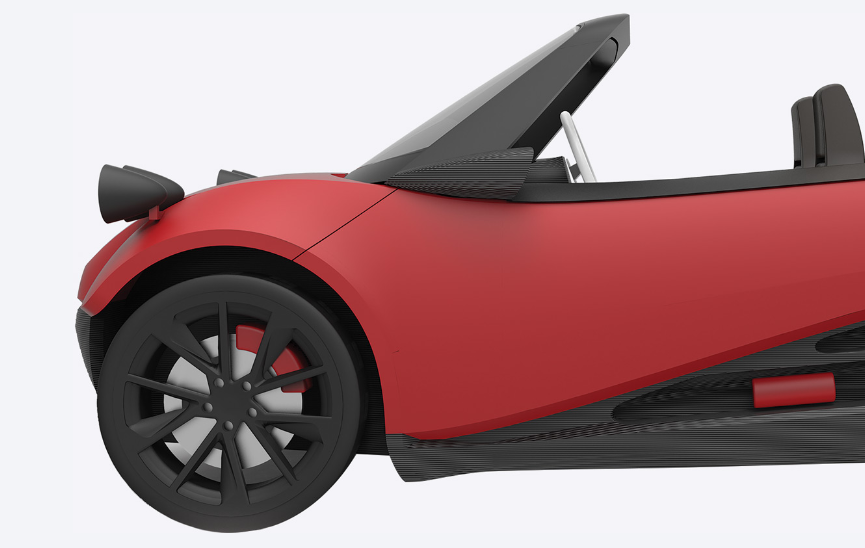
We spoke with creators of first 3D-printed car to uncover future of additive manufacturing
From footwear to guns, 3D printing has made tremendous advancements both in the breadth of what can be produced and the sophistication of end products. Many future-forward enterprises have adopted the technology in an effort to cut costs and manufacture extraordinary utilities, and the machinery has even downsized for early adopters to get their hands on consumer-grade models. One of the most astonishing products to emerge from the movement thus far is a full-fledged car, which came out of a collaboration between Europe’s largest engineering firm Siemens and automotive manufacturer Local Motors.
We caught up with representatives from both sides of the partnership, CEO of Siemens’ Industry Sector Helmuth Ludwig and Chief Strategy Officer of Local Motors Justin Fishkin, to understand how one of the larger, more functional 3D-printed articles—the LM3D Swim —came to be.

Of all the automobile manufacturers and corporations with 3D printing software capabilities, how did these two companies come together? As an open-source motor vehicle design firm—meaning products are co-created with the help of thousands of engineers and designers worldwide—Local Motors sources parts from micro-factories, which are highly automated factories of smaller dimensions (as the name implies) that enable manufacturers to save resources such as space, energy, materials and time, and as such require highly detailed software to run seamlessly. That’s where Siemens comes in; with its specialized Solid Edge® software, the team at Local Motors was able to quickly transition from concept to car with the simplicity of direct modeling (a method of designing which allows one to interact with designs like pushing, pulling or twisting items) and the flexibility of synchronous technology (a type of software that enables you to edit designs across different CAD systems—in this case Solid Edge®).
In retrospect, Siemens’ PLM software (product lifecycle management), which has been picked up by Ford, Maserati and even the Mars Rover, proved a perfect fit given Local Motors’ constraints.
“Local Motors combines global co-creation with distributed local production, to bring innovative vehicles (like the world’s first 3D-printed car) to market at unprecedented speeds. We achieve this through direct digital manufacturing (DDM), of which 3D-printing is a part,” affirms Fishkin. “Siemens’ powerful Solid Edge® software, a mainstream computer-aided design (CAD) application, has been used at Local Motors since 2011 and has been crucial in facilitating our co-creation model. It has helped Local Motors create the world’s first 3D-printed car, and additional software from Siemens will soon be implemented to help us push the boundaries of direct digital manufacturing even further.”
For a company like Local Motors, which is strongly rooted in its decentralized manufacturing process, 3D printing proves ideal for meshing designs from the cloud of some 60,000 users to create a joint byproduct. Imagine that the frame is brainstormed by someone from Italy, while a Michigan native models the engine, and a third person crafts the wheels over in China, and finally it gets printed in numerous micro-factories to get pieced together for the final product.
“Having a pool of 60,000 contributors all working on a design is a very broad group of inputs,” says Ludwig. “To make this all possible, our computer-aided analysis software is crucial in simulating the final product before it ever arrives physically. If you want to optimize your designs and know how certain parts will adapt dynamically, this can all be done from a computer. Additive manufacturing isn’t only about manufacturing though—it’s the ability to design honeycomb structures, cooling mechanisms, and generally complex systems. That’s our integrated view.”
Ludwig goes on to explain that Germany is proudly oriented in manufacturing, and is a worldwide leader in automation as we all know, whereas the United States is really big on software—he attributes much of the partnership’s success to the diversity of understanding that both parties bring to the table.
Back over in Phoenix, where Local Motors is headquartered, Fishkin offers us a glimpse into the company’s seamless operations, and how it facilitates smarter, higher-quality production:
“Since the days of Henry Ford, the automotive industry has defined efficiencies based on economies of scale—limited product mix, high volume production, low profit margins, and amortization of product-specific tooling and productive capacity over many years. Local Motors is defined by our economy of scope—we generate higher profit margins on fewer units of more models, because we don’t need to re-tool to produce new products.”
He goes on, “as technologies evolve, we upgrade existing vehicles and incorporate updates into new units produced, as needed and on demand. One of our core values is to safely reuse, recycle and repurpose locally.”
Indeed, the company’s flexibility enables it to be what Fishkin calls “evergreen integrators of new technology” in its products and process. The incorporation of additive manufacturing will enable Local Motors to melt broken 3D-printed parts into a base for reuse in future products. At the pre-printed stage, it may even be possible to upgrade swapped parts, making for a more modular and customizable experience. Ultimately customers will be able to choose the power source (e.g., gas, electric), body and so forth, and come pick up their newly printed car later on.

